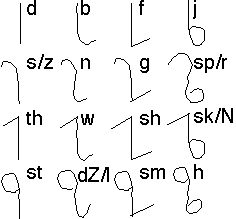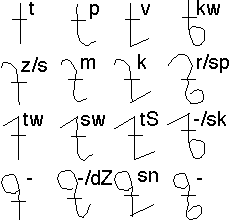
on this page:
This script is based on the Einigungssystem Stolze-Schrey, a kind of German stenography still used in Switzerland. It employs a unique way of representing the vowels which was invented by the Austrian Karl Faulmann (1835 - 1894). The same system is also used in the most widespread German stenography system, the deutsche Einheitskurzschrift, which adopted it from the Einigungssystem Stolze-Schrey.
The principle of the Faulmann way of representing the vowels consists in not having separate vowel signs, but in representing the vowel signs in the way the consonant signs are joined. Every consonant sign is formed by a downstroke. The connection of two consonant signs might be narrow or wide, the second consonant sign might be at the same height or lower or higher, and it might be written with normal or heavy pen pressure.
I haven't adopted all these discriminations, but only very few similar ones, but the principle is the same: Vowels are expressed by the way how consonant signs are joined.
There are two variants of this script, a simpler and yet more ornamental variant, and a straighter and yet more difficult variant. The difference is that in the straighter variant, the stems of the different consonants are directly joined, which requires certain special rules.
I imagine that the culture who developed this script would first have developed the simpler variant but use the other, clearer variant for everyday purposes. Children would be teached the simpler variant first.
The differences are after all in the representation of the vowels. I'm going to show both variants next to each other when they differ.
All consonant signs have the same structure: Head, stem, foot. Head and foot have the same forms. They can be either a straight, a bow, an angle, or a loop. The stems can be either a straight line or a crossed straight line.
The transcriptions are according to SAMPA, except for th and sh which refer to both the voiceless and the voiced sounds of [T, D] and [S, Z].
Where more than one transcription is given, the first refers to initial or final use, the second to medial.
normal stem:

crossed stem:

Four vowels are distinguished. That means that several vowel sounds we're used to distinguish aren't. Those who think that this wouldn't work may consider that the most popular shorthand system before Pitman didn't mark any vowels at all, the system invented by Samuel Taylor (1749 - 1811). If a script that didn't mark any vowels at all worked, then a script that marks four vowels will work anyway.
The vowels are:
Vowels are expressed by the way how two consonant signs are joined:
Examples of joining with a following straight head (on the left, there's the simpler variant, on the right, the straighter):
| straight | bow | angle | loop | |
| front low |  |
 |
 |
 |
| front high |  |
 |
 |
 |
| back high |  |
 |
 |
 |
| back low |  |
 |
 |
 |
In the straighter variant, the following vowels with a bow foot or bow head are irregular (note that this chart includes as well the regular forms of the simpler variant, and that the following chart may serve as an example that the forms given above can simply be turned around in order to represent other joinings):
| straight | bow | angle | loop | |
|
front high bow foot |
 |
 |
 |
 |
|
back high bow head |
 |
 |
 |
 |
|
back low bow foot |
 |
 |
 |
|
|
back low bow head |
 |
 |
 |
The initial and final vowels are basically the same as the intervocalic ones. Again, the bows of the straighter variant have slightly irregular forms. Here's a chart with all initial and final vowels:
| straight | bow | angle | loop | |
| front low |  |
 |
 |
 |
| front high |  |
 |
 |
 |
| back high |  |
 |
 |
 |
| back low |  |
 |
 |
 |
The r-consonant isn't used but between two vowels. All other instances of r are abbreviated.
The r-abbreviation is basically a loop.
The following abbreviations are used in direct joinings with the foots or heads:
| straight | bow | angle | loop | |
|
r + front low |

| 
| 
| 
|
The following abbreviation is used in joinings with the stem instead of the foot or the head (in this case, the loop is dropped):

These abbreviations are used in all cases, even with the irregular forms of the straight variant, e.g.:

Initial (and final) r is written in the following way:
| front low | front high | back high | back low | |
| r + |  |
 |
 |
 |
There is one irregular form for initial (and final) r:

In the straight variant, there's another irregular form:

The abbreviation of l works in the same way as the abbreviation of r. The only difference is that there's a heavy dot instead of the loop, e.g.:


An n before a consonant is indicated by a dot. This dot is normally on the left side of the preceding consonant. However, if the n precedes the first consonant (in words that begin with vowel or r, l), then it's placed on the right side of the following consonant.
The same sign indicates final stress in words that end with vowel, r or l (also on the left side of the preceding consonant).
Some abbreviations don't occur but in the straighter variant.
Following t or d and n are abbreviated with signs on the left side of the preceding consonant (t and d are represented with the same sign which reads always t but finally after voiced sounds) e.g.:


Preceding and following s or z are represented with bows either on the left side of the preceding consonant or, when initial, on the right side of the preceding consonant, e.g.:


In the sign for n, the stem is dropped in the following three cases:
 |
 |
 |
Obtuse angles like the following are avoided:

This is achieved by inclining the stem, but only if this stem is neither crossed nor preceded/followed by other signs (other consonants or initial/final vowels). In all other cases, the obtuse can't be avoided. Example:


This document has been written by J. 'Mach' Wust on Friday, 13th of august 2004. You can reach me at j_mach_wust at yahoo dot com.
This script has been developed in a long process (almost two years) of adapting the Einigungssystem Stolze-Schrey. I haven't tried to write down its exact rules because on one hand this'd be a very abstract description and on the other hand I haven't succeeded yet in describing all of them. This document rather tries to capture my current use of this, a use that has remained unchanged except for very few improvements for about a year now, so I think this is a pretty stable version.
I've been using this script mostly for Swiss German and Standard German, each of which has a special adaptation of the script, but I'm exhibiting an English version here because I think that this makes it more accessible.
It would be possible to create a better arrangement of the consonants, but then, the script would loose its last connection to the Einigunssystem Stolze-Schrey.
I've learned the Einigungssystem Stolze-Schrey from the following book:
Alge/Reber/Zürcher: Lehrbuch der deutschen Stenographie. Stolze / Schrey nach Systemurkunde 1967. Wetzikon: Verlag und Buchhandlung des Allgemeinen Schweizerischen Stenographenvereins, 1989.
If you like this script, you're free touse it unless you claim it your own.